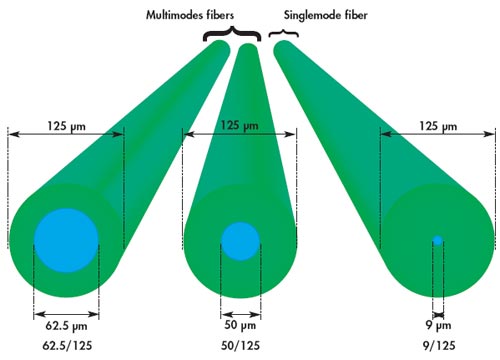Recently, fiber optic cable becomes more popular in telecommunication because of its great bandwidth, fast speed, long distance transmission and low cost. Single mode fiber and multimode fiber optic cables are important in many networks to transmit optical signals. Though they have the same working principle and functions, each of them has their own advantages and disadvantages.
People who have work experiences with optical networks may be familiar with fiber optic cables. And they may know the basic structure and differences between multimode and single mode fiber optic cable. Here is a simple table showing the basic knowledge of them.

From the table we can see, multimode fiber cable has a larger core diameter. And it has multiple transmission modes, but they are only suitable for short distance connections. While single mode fiber has a small core diameter, through which only one mode will propagate typically 1310 or 1550nm. Because of that, these cables are often deployed in long distance transmission due to its less dispersion. Following is a direct-viewing picture shows the diameter differences between single mode fiber and multimode fiber cables.

As has mentioned above, single mode fiber optic cable is more suitable for long runs applications when compared with multimode fiber cable. Except for this, single mode fiber cable also has other three advantages.
- Increase bandwidth capacity.
- Limited Data Dispersion & External Interference. The single input mode allows SMF to limit light scattering, which in turn reduce light waste and increase data transmission data.
- Fast Transmission Speed. Single mode fiber cable can support data transmission speed up to 10Gbps.
Each coin has two sides. Single mode fiber cable also has disadvantages. The most one is the cost. Although it has better performance in long runs transmission than multimode fiber cable, single mode fiber cables often cost more.
With a larger fiber core and good alignment tolerances, multimode fiber cable and components are less expensive and are easier to work with other optical components like fiber connector and fiber adapter, when compared with single mode fiber cable. In addition, multimode fiber cable also provides high speed and high bandwidth over short distances. And they allows several mode optical signals transmitted at the same time.
However, multimode fiber cable has high dispersion and attenuation rate, the quality of optical signals is reduced as the transmission distance is getting longer. Therefore, multimode fiber cable is often used in data and audio/video applications in LANs.
Owning to their own characteristics, single-mode fiber cable and multimode fiber cable have different application areas. Based on the transmission distance and deployment budget, if the transmission distance is less than 10 miles, the multimode fiber cable is better, for it needs less expensive optical transceiver and other components. And if the distance is over 10 miles, single mode fiber will be needed.
Related Article: Single Mode vs Multimode Fiber: What’s the Difference?
